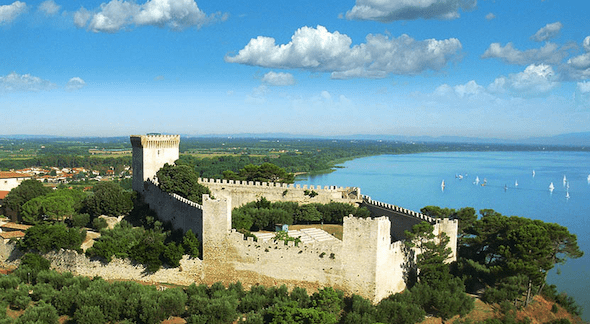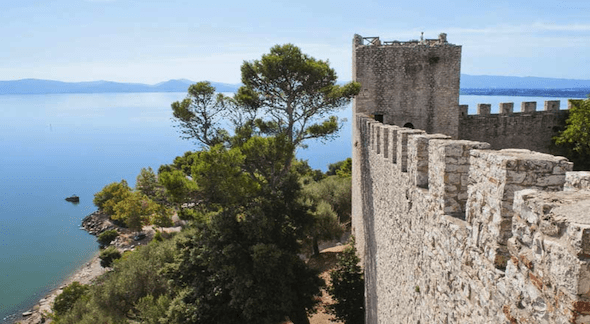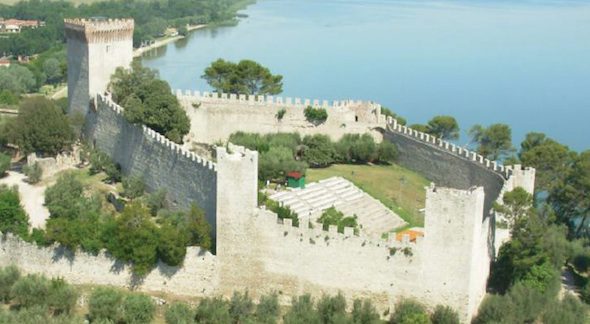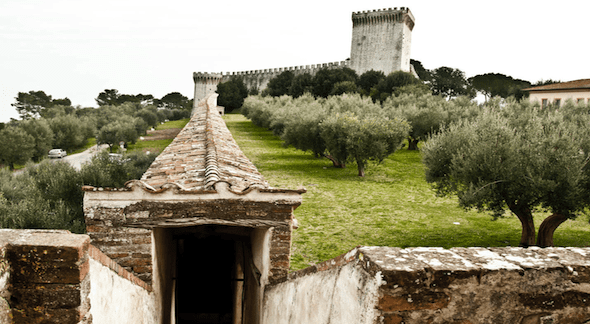La Rocca Medievale di Castiglione del Lago, più conosciuta come Rocca del Leone, permette di immergersi in un’autentica atmosfera d’altri tempi.
Il panorama di cui si gode dalla Rocca è mozzafiato, un mix speciale tra la bellezza della natura umbra, i colori e riflessi delle acque del Lago Trasimeno e sentori di Toscana, con lo sguardo che arriva alla Val di Chiana e alla vicina Cortona.
La Rocca si staglia fin da lontano con la sua cinta muraria merlata “alla guelfa”, le quattro torri di fortificazione collocate nei quattro angoli principali e l’imponente mastio triangolare, con un’altezza di oltre 30 metri.
La Rocca è un luogo magico, sospeso nel tempo e anche nello spazio, poiché domina la parte orientale del centro abitato di Castiglione del Lago, quella che si protende verso il Lago.

La storia e lo sviluppo della Rocca e del Palazzo del borgo di Castiglione del Lago vanno di pari passo. Entrambi sono visitabili e sono collegati grazie ad un suggestivo camminamento. L’ingresso alla Rocca si effettua oggi direttamente attraverso l’ingresso al Palazzo, in via Antonio Gramsci 1.
Arricchisci la tua giornata al Trasimeno con una visita al borgo di Castiglion del Lago, alla sua Rocca e al Palazzo.
Segui i nostri consigli per tutte le informazioni utili!
√ per saperne di più sul Palazzo, detto Della Corgna, vai al nostro articolo Il Palazzo della Corgna
√ per conoscere meglio la Rocca Del Leone e tutti i dettagli della visita, continua a leggere qui sotto, parleremo di:
- la Storia della Rocca del Leone
- informazioni pratiche per visitare la Rocca del Leone

LA STORIA DELLA ROCCA DEL LEONE
Per molti secoli la Rocca ha costituito il più importante insediamento militare sulle sponde del Lago Trasimeno. Grazie alla sua imponente presenza e alla vista dall’alto che garantiva, rappresentava un punto di osservazione e difesa strategico.
Il grandioso edificio fu voluto da Federico II di Svevia nel XII secolo per dislocare le proprie truppe, attraverso gli interventi dell’architetto senese Lorenzo Maitani e di Frate Elia Coppi da Cortona, progettista fra l’altro anche della prima Basilica del Santo ad Assisi. Il complesso fu sviluppato a partire dalle rovine di una precedente fortificazione, distrutta nel 1901 da Enrico IV di Franconia durante le guerre tra Arezzo e Perugia. La precedente costruzione era nata sui resti di un edificio più antico dedicato al culto dei Santi Filippo e Giacomo, di cui rimangono pochi ruderi, a sua volta eretto su di un’antichissima acropoli etrusca.
Dopo alterne vicende, nel 1503 Giampaolo Baglioni vi stabilì la propria residenza e dispose il restauro e l’ampliamento dell’intero complesso. Il progetto è comunemente attribuito a Vignola, anche se i lavori proseguirono in modo efficace grazie all’intervento di Ascanio della Corgna, esperto in architettura militare.
Fu innalzato un tratto di mura che dal Palazzo giungeva in prossimità del Mastio, tutt’ora in parte visibile; nel Mastio venne inserito un sistema di accesso tramite scale di legno mobili, che potevano essere ritirate in caso di attacco; due torri furono sostituite con bastioni cilindrici, la cui struttura rotonda garantiva maggior resistenza gli attacchi di cannoni.
Gli interventi di fortificazione furono ultimati nella seconda metà del 1500 e resero la Rocca nota in tutta Europa come uno dei Castelli più imponenti e più difficili da attaccare dell’epoca.
Successivamente, a partire dai precedenti edifici trecenteschi, fu restaurato ed ampliato il Palazzo Ducale, il già citato Palazzo della Corgna, oggi sede del Municipio. Inoltre, fu aggiunta una serie di giardini italiani all’interno della cinta muraria.
Il Complesso della Rocca e del Palazzo, dopo la morte di suo nipote il Duca Fulvio II, passarono sotto la giurisdizione pontificia ed infine, nel 1860, al comune di Castiglione del Lago.

INFORMAZIONI PRATICHE PER VISITARE LA ROCCA DEL LEONE
Per la visita al complesso museale che comprende la Rocca del Leone e il Palazzo, ti consigliamo di lasciare l’auto nei parcheggi che sono situati al di fuori delle mura del borgo di Castiglione del Lago. Entra nel borgo a piedi e percorri poi la strada principale, in pochi minuti giungerai a Piazza Gramsci e all’ingresso del Palazzo.
Si accede infatti alla Rocca del Leone attraverso l’ingresso al Palazzo della Corgna, percorrendo il camminamento coperto che collega i due edifici.
La Rocca osserva i seguenti orari, variabili a seconda del periodo dell’anno, con l’ultimo ingresso da effettuarsi 45 minuti prima dell’orario di chiusura.
Dal 01 MARZO al 26 MARZO –> Apertura 10:00 – 18:00
Dal 26 MARZO al 30 SETTEMBRE –> Apertura 09:30 – 19:00
Dal 01 OTTOBRE al 02 NOVEMBRE –> Apertura 09:30 – 18:30
*Dal 03 NOVEMBRE al 28 FEBBRAIO Apertura 10:00 – 17:00
*Venerdì, Sabato, Domenica, Lunedì, festivi e prefestivi. Ad eccezione del periodo natalizio durante il quale il complesso è aperto tutti i giorni.
I seguenti prezzi sono validi fino al 27 Agosto e comprendono:
– visita alla Rocca del Leone
– visita al Palazzo della Corgna
– visita alla Mostra “Picasso: la materia e il segno. Ceramica e Grafica.”
Biglietto € 5,00
Biglietto Residenti € 4,00
Ingresso gratuito per bambini fino ai 6 anni di età
Biglietto Famiglia
Biglietto Famiglia (3 persone) €18,00 – se residenti € 10,00
Biglietto Famiglia (4 persone) € 21,00 – se residenti € 12,00
Visite Guidate per gruppi di almeno 20 persone tramite prenotazione, con prezzo da concordare al momento della prenotazione: Tel. 075 951099; mail. cooplagodarte94@gmail.com

BUONA VISITA ALLA ROCCA DEL LEONE E AL PALAZZO
DALLO STAFF DI BELLAUMBRIA
Rocca del Leone of Castiglione del Lago is a magnificent building which for centuries has been the most important military settlement placed on the shores of Lake Trasimeno and is formed by a wall with battlements polygonal Guelph , four towers and the triangular keep. It was begun in XII century on the ruins of an earlier fortification destroyed in 1091 by Henry IV ( 1050-1106 ) of Franconia. In 1297 the magistrates of Perugia decided to fortify the town and the next year they decided to build a fortress inside the castle to better defend the inhabitants.
>> Do you want to visit Castiglione del Lago? Check it out now of the best Farm-Houses in Castiglione del Lago, Italy

In 1501 Giampaolo Baglioni stabled here his residence, taking care to restore and expand the complex , works continued under his son and were completed by Ascanio Della Corgna I ( 1516-71 ). In 1554 Ascanio replaced some of the towers of the fortress with bastions and also by providing cylindrical create within the walls of a number of Italian gardens . He built the mansion that is now the seat of the town hall , restoring and expanding fourteenth-century buildings . Diomede, the adopted son of Ascanio I, made this palace in Castiglione del Lago become a literary salon, called The Gardens of Maecenas . The fortress, after the death of his nephew Fulvio II, came under the jurisdiction of the Apostolic Chamber and in 1860 to the municipality of Castiglione del Lago.
>> Do you want to discover Castiglione del Lago‘s treasures? Check it out now of the best farmhouses in Castiglione del Lago.
Alberto Grohmann relates : ” In the plant urban based on a checkerboard pattern , with a module with a square base repeated six times, can be traced clearly the number 3 . The town , in fact, three squares , three main streets , three doors , and also the keep of the tower has a triangular plan . “
From the tower you can enjoy a splendid view over the Val di Chiana and nearby Cortona, accessing by a striking passage that connects Palazzo della Corgna.
There are offers for vacation rentals in the area of Castiglione del Lago! Click and Consult them immediately.
Rocca del Leone of Castiglione del Lago is a magnificent building which for centuries has been the most important military settlement placed on the shores of Lake Trasimeno and is formed by a wall with battlements polygonal Guelph , four towers and the triangular keep. It was begun in XII century on the ruins of an earlier fortification destroyed in 1091 by Henry IV ( 1050-1106 ) of Franconia. In 1297 the magistrates of Perugia decided to fortify the town and the next year they decided to build a fortress inside the castle to better defend the inhabitants.
>> Do you want to visit Castiglione del Lago? Check it out now of the best Farm-Houses in Castiglione del Lago, Italy

In 1501 Giampaolo Baglioni stabled here his residence, taking care to restore and expand the complex , works continued under his son and were completed by Ascanio Della Corgna I ( 1516-71 ). In 1554 Ascanio replaced some of the towers of the fortress with bastions and also by providing cylindrical create within the walls of a number of Italian gardens . He built the mansion that is now the seat of the town hall , restoring and expanding fourteenth-century buildings . Diomede, the adopted son of Ascanio I, made this palace in Castiglione del Lago become a literary salon, called The Gardens of Maecenas . The fortress, after the death of his nephew Fulvio II, came under the jurisdiction of the Apostolic Chamber and in 1860 to the municipality of Castiglione del Lago.
>> Do you want to discover Castiglione del Lago‘s treasures? Check it out now of the best farmhouses in Castiglione del Lago.
Alberto Grohmann relates : ” In the plant urban based on a checkerboard pattern , with a module with a square base repeated six times, can be traced clearly the number 3 . The town , in fact, three squares , three main streets , three doors , and also the keep of the tower has a triangular plan . “
From the tower you can enjoy a splendid view over the Val di Chiana and nearby Cortona, accessing by a striking passage that connects Palazzo della Corgna.
There are offers for vacation rentals in the area of Castiglione del Lago! Click and Consult them immediately.
Rocca del Leone of Castiglione del Lago is a magnificent building which for centuries has been the most important military settlement placed on the shores of Lake Trasimeno and is formed by a wall with battlements polygonal Guelph , four towers and the triangular keep. It was begun in XII century on the ruins of an earlier fortification destroyed in 1091 by Henry IV ( 1050-1106 ) of Franconia. In 1297 the magistrates of Perugia decided to fortify the town and the next year they decided to build a fortress inside the castle to better defend the inhabitants.
>> Do you want to visit Castiglione del Lago? Check it out now of the best Farm-Houses in Castiglione del Lago, Italy

In 1501 Giampaolo Baglioni stabled here his residence, taking care to restore and expand the complex , works continued under his son and were completed by Ascanio Della Corgna I ( 1516-71 ). In 1554 Ascanio replaced some of the towers of the fortress with bastions and also by providing cylindrical create within the walls of a number of Italian gardens . He built the mansion that is now the seat of the town hall , restoring and expanding fourteenth-century buildings . Diomede, the adopted son of Ascanio I, made this palace in Castiglione del Lago become a literary salon, called The Gardens of Maecenas . The fortress, after the death of his nephew Fulvio II, came under the jurisdiction of the Apostolic Chamber and in 1860 to the municipality of Castiglione del Lago.
>> Do you want to discover Castiglione del Lago‘s treasures? Check it out now of the best farmhouses in Castiglione del Lago.
Alberto Grohmann relates : ” In the plant urban based on a checkerboard pattern , with a module with a square base repeated six times, can be traced clearly the number 3 . The town , in fact, three squares , three main streets , three doors , and also the keep of the tower has a triangular plan . “
From the tower you can enjoy a splendid view over the Val di Chiana and nearby Cortona, accessing by a striking passage that connects Palazzo della Corgna.
There are offers for vacation rentals in the area of Castiglione del Lago! Click and Consult them immediately.
Rocca del Leone of Castiglione del Lago is a magnificent building which for centuries has been the most important military settlement placed on the shores of Lake Trasimeno and is formed by a wall with battlements polygonal Guelph , four towers and the triangular keep. It was begun in XII century on the ruins of an earlier fortification destroyed in 1091 by Henry IV ( 1050-1106 ) of Franconia. In 1297 the magistrates of Perugia decided to fortify the town and the next year they decided to build a fortress inside the castle to better defend the inhabitants.
>> Do you want to visit Castiglione del Lago? Check it out now of the best Farm-Houses in Castiglione del Lago, Italy

In 1501 Giampaolo Baglioni stabled here his residence, taking care to restore and expand the complex , works continued under his son and were completed by Ascanio Della Corgna I ( 1516-71 ). In 1554 Ascanio replaced some of the towers of the fortress with bastions and also by providing cylindrical create within the walls of a number of Italian gardens . He built the mansion that is now the seat of the town hall , restoring and expanding fourteenth-century buildings . Diomede, the adopted son of Ascanio I, made this palace in Castiglione del Lago become a literary salon, called The Gardens of Maecenas . The fortress, after the death of his nephew Fulvio II, came under the jurisdiction of the Apostolic Chamber and in 1860 to the municipality of Castiglione del Lago.
>> Do you want to discover Castiglione del Lago‘s treasures? Check it out now of the best farmhouses in Castiglione del Lago.
Alberto Grohmann relates : ” In the plant urban based on a checkerboard pattern , with a module with a square base repeated six times, can be traced clearly the number 3 . The town , in fact, three squares , three main streets , three doors , and also the keep of the tower has a triangular plan . “
From the tower you can enjoy a splendid view over the Val di Chiana and nearby Cortona, accessing by a striking passage that connects Palazzo della Corgna.
There are offers for vacation rentals in the area of Castiglione del Lago! Click and Consult them immediately.






Comment (0)